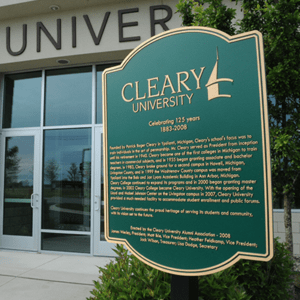Contact The
Financial Aid Team
(800) 686-1883 x5005 for Financial Aid
finaid@cleary.edu | Fax: (517) 338-5041
Cleary University
The Office of Financial Aid encourages all students to apply even if they think they are not eligible, as assistance is available on a need and non-need basis. A FAFSA application must be completed to be considered for Cleary University institutional grants and scholarships.


(800) 686-1883 x5005 for Financial Aid
finaid@cleary.edu | Fax: (517) 338-5041
The FAFSA Simplification Act represents a major overhaul of the processes and systems used to award federal student aid. Starting with the 2024–2025 award year, the FAFSA has been revamped and many policies and procedures for schools that participate in federal financial aid programs had changed. At Cleary University, the 2024-2025 FAFSA covers fall 2024, spring 2025, and summer 2025.
Simplification:
The maximum number of questions will be reduced from 108 to 46 for most students. Depending on their circumstances, some students will need to answer even fewer questions due to the dynamic skip logic built into the application. Additionally, providing income and tax information will be expedited under the process addressed in the next bullet.
Income and Tax Data:
Previously, income and tax information was provided by using the IRS Data Retrieval Tool (DRT) to transfer data from the IRS to the FAFSA or by entering this information manually. Beginning with 2024-2025, all persons listing tax information on the FAFSA will be required to use the IRS Direct Data Exchange (DDX) to share income and tax information or confirm non-filing status.
FAFSA Contributors: All those reporting income and tax data on the FAFSA will need to have an FSA ID if they don’t have one already. FAFSA contributors include the student, student spouse (if the student is married), parent, and other parent (if the parent reported on the FAFSA is married). If married individuals filed their taxes separately, both spouses will need to obtain an FSA ID.
Student Aid Index (SAI): The FAFSA previously calculated an Estimated Family Contribution (EFC). Now the FAFSA will produce the Student Aid Index (SAI), which is used to determine your eligibility for federal student aid. The SAI, unlike the EFC, can be negative with the minimum SAI being -1500.
Additional changes that will affect some applicants: Divorced or Separated Parent Information on the FAFSA: In prior years if the student’s parents were divorced or separated, the student was instructed to include on the FAFSA the parental data of the parent with whom they lived the most in the previous 12 months. Starting with the 2024-2025 FAFSA, the student will need to include the parental data of the parent who provided the most financial support in the previous 12 months. If this parent has remarried, both the parent and stepparent’s information is required. If both biological parents provide equal support, the student is then instructed to include the parental data of the parent who earned more.
Number of Students in College No Longer Factored: The FAFSA previously prorated the EFC based on the number of household members that were in college. The 2024-2025 FAFSA will still ask how many household members are in college, however your answer will not be calculated into the SAI. Consequently, current students with siblings in college most likely will see a change in their need-based aid eligibility under the 2024-2025 FAFSA.
Inclusion of family farms and small businesses: In past years, the value of a family farm or a small business with fewer than 100 employees was not reported. Beginning with the 2024-2025 FAFSA, the net worth of each will be part of the FAFSA calculation.
Automatic Pell Grants based on income and household size: The FAFSA Simplification Act extends the Federal Pell Grant to more students and links eligibility to family size and the federal poverty level. Families making less than 175% and single parents making less than 225% of the federal poverty level will see their students receive a maximum Federal Pell Grant award. Minimum Pell Grants will be guaranteed to students from households below 275%, 325%, 350%, or 400% of the poverty level, depending on household structure. Pell awards between the maximum and minimum amounts will be determined by SAI.
Dependency status questions that determine if your parents must provide information on your FAFSA remain the same.
The FAFSA will request tax information from the prior-prior tax year. Families with significant reductions in income levels can review the special circumstances process.
Degree-seeking students will be eligible for federal student loans assuming they complete the FAFSA, have not reached annual or aggregate limits, are enrolled at least half-time, and are not in default on previous federal student loans.
Undergraduate admission applications for 2024-2025 should be completed by January 1, 2024 for Cleary scholarship consideration.
It is recommended the FAFSA be filed and other required documents be submitted to the Financial Aid Office by the priority date – for the 2024-2025 academic year, the priority date is March 1, 2024. Applications completed after this date may be too late for certain aid programs with limited funding.
With the 2025-2026 FAFSA, the FAFSA is again expected to be available beginning October 1 of each year.
The FAFSA remains the application for new freshmen and for transfer students to receive a financial aid offer from Cleary. The delay of FAFSA availability until December does slightly shorten the window for applying for aid, and Cleary will work to begin awarding aid for new students with FAFSAs on file as soon as systems are ready. Anticipated timelines in awarding will be detailed here.
Create a FAFSA account. All participants with a Social Security Number (SSN) should create an FSA ID.
Use this tool to see how much federal student aid you may be eligible for in the 2024–25 award year. (Based on the SAI.
All parent and spouse participants, with or without a SSN, can complete a FAFSA application.
Check out this reference page. We will continue to update and add solutions as we find information that may be helpful to you.
Apply for Admission
Apply for Financial Aid
Watch your email for updates from the Cleary Financial Aid Office
Submit all requested documents
Watch for your financial aid offer letter
Accept your offers in the Financial Aid Portal using the link provided in your Financial Aid Offer email
Pay your bill or contact the business office to make payment arrangements
Check your email regularly for changes and updates
Need information on how to make a deposit during enrollment, or pay tuition or other fees. This is the right place.
This calculator is intended to provide estimated net price information (defined as estimated cost of attendance - including tuition and required fees, books and supplies, room and board (meals), and other related expenses - minus estimated grant and scholarship aid) to current and prospective students and their families based on what similar students paid in a previous year.
There are many scholarships and grants available for higher education today, which can sometimes be hard to find. Cleary University is dedicated to helping students afford higher education. We can work with you to find scholarships you can apply for to ease the cost of college and graduate school.
Cleary graduates use their business arts education to become the employees, entrepreneurs, and leaders who transform the marketplace…and the world.
Follow Us
HOWELL
DETROIT
